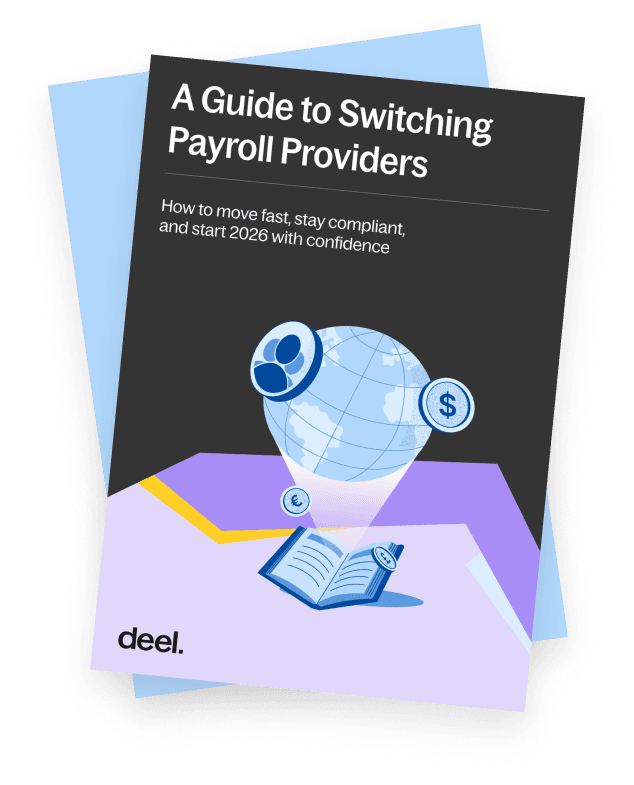Article
12 min read
What to Know Before Switching Payroll Providers for 2026
US payroll
Global payroll

Author
Shannon Ongaro
Last Update
November 24, 2025

Table of Contents
Why companies switch payroll providers
When to switch payroll providers
What are the steps to switching payroll providers?
What is the best payroll provider to use?
Benefits of switching to Deel Payroll
Key takeaways
- Businesses often change payroll providers when errors, poor support, high costs, or limited integrations start affecting pay accuracy, compliance, and team efficiency.
- When planning your payroll switch, consider country-specific tax reporting deadlines to simplify reconciliation and avoid compliance overlaps.
- Deel Payroll combines guided onboarding, automated compliance in 130+ countries, and integrations with leading platforms to make even complex, multi-entity transitions straightforward.
Most companies stick with their payroll provider longer than they should. Not because they’re happy, but because switching payroll providers feels like too much of an undertaking.
Payroll touches every employee, every pay period, and every tax deadline, so the idea of changing systems can seem overwhelming.
But there comes a time when sticking with the status quo causes more problems than it solves. With the right timing and team to guide the process, changing payroll providers can set your team up for long-term success.
This article will walk you through how to plan a payroll provider transition step by step. It covers when to make the move, what to watch out for, and how to ensure a smooth, compliant handover no matter where your team operates.

Why companies switch payroll providers
If payroll feels harder than it should, your provider may be holding you back. Here are a few key warning signs that it’s time to make a change:
-
Frequent payroll errors: Mistakes in pay or deductions can damage employee trust and expose your business to compliance risks.
-
Poor customer service: Slow or unhelpful support leads to delays, downtime, and frustration across your payroll team.
-
Limited system integration: If your payroll doesn’t sync smoothly with HR, time tracking, or benefits platforms, you’re wasting time on manual data entry.
-
High costs and hidden fees: Unexpected charges or service fees can strain budgets—something 42% of payroll leaders have experienced, according to a Forrester study commissioned by Deel.
-
Weak reporting and compliance tools: A lack of visibility into payroll data and compliance gaps can create financial and legal exposure.
How Bitpanda transitioned to Deel at record speed
Bitpanda is one of the fastest-growing fintech companies in Europe. To round out their tech stack, they needed a truly global payroll solution. During this time, one of their existing local payroll providers sent them an alarming notification: They weren’t going to pay Bitpanda’s team in the Netherlands, and it was less than a week before payday.
They needed a fix, fast.
Lindsay Ross, Bitpanda CHRO, reached out to Deel and within a week, Bitpanda’s Netherlands team was on Deel Payroll—and being paid without missing a beat.
“The Deel team went above and beyond to migrate an entire country’s payroll from our previous provider to Deel Payroll in just seven days.” — Lindsay Ross, CHRO, Bitpanda
When to switch payroll providers
The best time to switch payroll providers is typically at the start of a new quarter, tax year, or on January 1, when tax reporting and payroll records can begin cleanly under the new system.
Switching at a natural boundary helps avoid data overlap, simplifies reconciliation, and ensures your tax filings stay accurate.
However, if your current provider is causing frequent errors, compliance risks, or employee dissatisfaction, don’t wait for the perfect timing.
Can you switch payroll providers mid-year?
Yes, you can switch payroll providers mid-year.
The key is choosing a provider that knows how to handle year-to-date data and tax transitions properly. A smooth switch requires careful review of your year-to-date payroll data, ensuring taxes are filed correctly, and aligning what’s been paid with what still needs to be processed.
As one of Deel’s payroll implementation experts explains:
“If you don’t have a company that’s willing to take the time to ingest your data and do your calculations correctly, then yes, [switching payroll providers mid-year] can be complicated. But if they’re taking the time to ask the right questions, understand what you’re looking to solve for, or are able to pull those layers back and begin to reverse-engineer that project plan, then it’s not complicated.”
Deel Payroll
What are the steps to switching payroll providers?
Switching payroll providers requires clear justification, strategic timing, and structured execution. Use this checklist to plan your migration.
Step 1: Make your business case
Start by showing leadership how switching providers supports business goals. Identify key pain points—manual work, compliance risk, or vendor dependency—and quantify their impact in time, cost, and risk. Build an ROI model tied to automation and consolidation, highlighting faster cycles, reduced costs, and scalability. Align the case with leadership priorities like efficiency, visibility, and accuracy.
Step 2: Pick the right moment to move
Timing matters. Choose a switch window that avoids payroll overlap and aligns with fiscal or tax years. In the US, move before December close to avoid year-end filings. In Brazil, migrate before 13th-month salary payouts. For the UK, target early Q1, and in APAC regions like India or Australia, align with the fiscal year-end. Allow time for testing and run a soft parallel payroll before go-live.
Step 3: Document your payroll operations
Map your entire payroll process before evaluating vendors. List every system (HRIS, ERP, time-tracking), define data sources, and document headcounts and pay frequencies. Note recurring compliance issues and manual tasks that slow you down. A clear process map helps identify integration needs and migration risks early.
Step 4: Choose your provider and launch plan
Select a payroll provider that can manage global complexity and compliance. Form a cross-functional selection team and define clear success metrics. Ask scenario-based questions and review data privacy and automation capabilities.
If you choose Deel, the guided migration includes planning, a data audit, and a parallel run, then go-live with continued post-launch support.

Step 5: Keep employees informed
Communication builds trust. Explain the “why” behind the change, outline benefits, and notify employees early about any changes to pay dates or tax forms. Share FAQs, quick guides, and support contacts. Deel provides direct local support so employees get fast, accurate help without intermediaries.
Step 6: Track your progress
Measure results from day one. During migration, validate payroll data and track testing milestones. After go-live, monitor accuracy, timeliness, and employee satisfaction. Conduct a 90-day optimization to review your progress with your payroll manager.
Consider using Deel Payroll Connect to instantly see how each entity and provider is performing from one unified dashboard, making it easy to monitor KPIs and spot issues early.
Learn more in our complete guide to switching payroll providers.
Leading Global Hiring Platform
What is the best payroll provider to use?
Choosing the best payroll provider largely depends on your business size, workforce structure, and geographic reach. That said, one of the strongest contenders in the all-in-one space is Deel, which is built for global, local, full-service or self-service payroll, including direct employees, contractors, and EOR/PEO models.
Explore how Deel stacks up to competitors:
Everyone told me I was crazy to switch seven payrolls in under six months, given that I am a solo HR team—but Deel made it happen.
—Akésia Doubrere,
HR Manager, Cohabs
Benefits of switching to Deel Payroll
With a structured implementation, automation that reduces manual effort, and a global team of in-house experts for every country, Deel Payroll takes on the heavy lift of payroll management for you.
-
Proven track record: Deel is trusted by thousands of companies in 130+ countries, from small businesses to global enterprises
-
Expert-led implementation: Our specialists guide you through planning, integration, testing, and go-live so your teams can stay focused on business continuity
-
Deep in-house expertise: Unlike providers who outsource, Deel relies on in-house payroll and compliance experts who are on the ground in every country
-
Enterprise-grade integrations: Deel is a Certified Workday GPC partner and integrates with SAP SuccessFactors for seamless data sync across your entire HR and Finance stack
Switch to Deel Payroll and start 2026 with confidence. Book a 30-minute demo to speak with an expert directly.
FAQs
Is it easy to switch payroll companies?
Switching payroll companies can be straightforward with the right planning and provider, but it’s never effortless. Modern platforms streamline migrations and offer onboarding support, but businesses still need to manage data transfers, timing, and communication.
Challenges like moving historical payroll data, coordinating across HR and finance, and aligning with contract end dates can complicate the process. Choosing a provider experienced in transitions—especially one offering hands-on implementation—makes the switch smoother and helps ensure pay accuracy and compliance from day one.
How long does it take to switch payroll providers?
With Deel, enterprises can go live in one to three months per entity. Small businesses and mid-size companies can set up payroll in as little as 10 days through our self-guided onboarding. Our implementation process doesn’t involve third parties, so you get up and running faster.
How do I compare payroll providers before switching?
Compare payroll providers by evaluating features, pricing transparency, scalability, compliance support, and integration capabilities. Look for automated tax filings, HRIS and accounting integrations, global payroll or contractor support, and dedicated onboarding assistance. Prioritize data migration ease, responsive customer service, and clear pricing to ensure a seamless transition.
Consider using a payroll RFP template to simplify payroll provider comparisons.
How does switching to a cloud-based payroll provider help?
Cloud-based payroll systems offer real-time access, automation, and scalability for growing or distributed teams. They reduce IT maintenance costs, ensure compliance with regular updates, and improve accuracy through automated calculations. The result is a more flexible, secure, and efficient payroll process that supports modern, global workforces.
Learn more: How Cloud-Based Payroll Software Improves Your Daily Workflow

Shannon Ongaro is a content marketing manager and trained journalist with over a decade of experience producing content that supports franchisees, small businesses, and global enterprises. Over the years, she’s covered topics such as payroll, HR tech, workplace culture, and more. At Deel, Shannon specializes in thought leadership and global payroll content.















